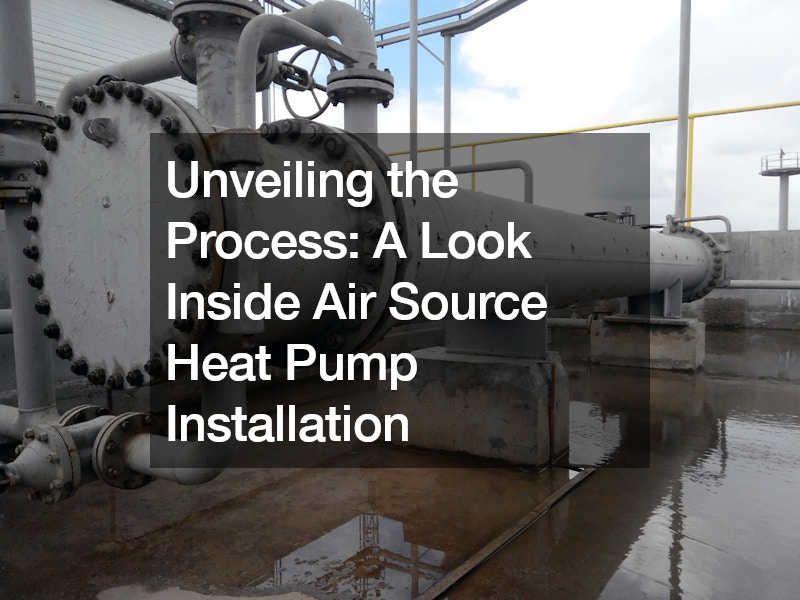
As the world strives for sustainable energy solutions, air source heat pumps (ASHPs) are gaining traction in both residential and commercial settings. These innovative systems extract heat from the ambient air to provide efficient heating and, in some models, hot water. Understanding the air source heat pump installation process is crucial for homeowners, businesses, and anyone interested in this technology.
This article delves into the key steps involved in a typical ASHP installation, exploring the components and highlighting the collaborative approach often employed by professionals.
Planning and System Design A well-designed system is essential for optimal performance and efficiency. This initial phase involves:
Site Assessment: A qualified technician will visit the property to assess factors like building size, insulation levels, and existing heating system. This information helps determine the appropriate ASHP capacity to meet the building’s heating requirements.
Heat Loss Calculations: Sophisticated software or manual calculations estimate the building’s heat loss rate, which is crucial for selecting the right size ASHP unit. An undersized unit will struggle to keep the building warm, while an oversized unit can be inefficient and lead to higher running costs. System Design: Based on the site assessment and heat loss calculations, the technician designs the complete air source heat pump system. This includes selecting the appropriate ASHP unit, determining the location of the outdoor unit, and planning the pipework for connecting the indoor and outdoor components. Collaboration for Efficient Installation Air source heat pump installation typically involves collaboration between two specialists:
MCS-certified Installer: The Microgeneration Certification Scheme (MCS) ensures installers possess the necessary qualifications and training to work with renewable technologies like ASHPs. This certified installer will handle the physical installation of the system, including pipework, electrical connections, and mounting the outdoor unit. Air Source Heat Pump Design Specialist: This specialist, often affiliated with a renewable energy company, focuses on the design and planning aspects. They conduct the initial assessment, perform heat loss calculations, and design the entire ASHP system layout for optimal performance. This separation allows certified installers to focus on their expertise while ensuring a well-designed system is being implemented. Installing the Air Source Heat Pump System Once the planning and design are complete, the installation phase commences:
Preparing the Plant Room: A dedicated space within the building, often a utility room or garage, will house the indoor unit and other essential components. This space needs to be cleared and prepared for the installation. Installing the Indoor Unit: The indoor unit, which houses the heat exchanger and control panel, is securely mounted within the designated space in the plant room. Connecting the Pipework: Insulated pipes are installed to connect the indoor unit to the outdoor unit. This pipework carries a water-glycol mixture that transfers heat between the units. The design ensures proper flow and minimizes heat loss during transfer. Positioning the Outdoor Unit: The outdoor unit, which extracts heat from the ambient air, is positioned outside the building on a stable platform. Regulations typically require maintaining a minimum distance from property lines and windows for noise and airflow considerations. Electrical Connections: Qualified electricians handle connecting the system to the building’s electrical grid, ensuring proper power supply and safety measures. The Crucial Commissioning Stage After the physical installation is complete, a commissioning process ensures the system functions optimally:
System Checks: The technician meticulously checks the entire system for leaks, proper refrigerant levels, and secure electrical connections. Control Panel Configuration: The system’s control panel is configured based on the design specifications and building requirements. This includes setting desired heating temperatures, hot water schedules (if applicable), and defrost cycle parameters. Performance Testing: The technician performs a series of tests to verify the system’s functionality. This includes evaluating heating performance, hot water production (if applicable), and overall energy efficiency. Once everything is functioning as intended, the system is handed over to the homeowner or building manager. Additional Considerations for a Successful Air Source Heat Pump Installation Existing Heating System Integration: In some cases, the existing heating system may be integrated with the ASHP to provide backup heating during extreme cold spells. This can be achieved through a three-way valve system that automatically switches between the ASHP and the backup system. Cleaning the Old System: Before connecting the ASHP to the existing pipework, it’s crucial to clean the old boiler system thoroughly. This eliminates any debris or sediment that could clog the new system and impact its performance. Importance of Fresh Water: Using clean, fresh water in the closed-loop system of the ASHP helps prevent corrosion and clogging within the outdoor unit.Conclusion: Unveiling Efficiency and Sustainability By unveiling the air source heat pump installation process, we gain a deeper understanding of this technology’s potential to contribute to a more sustainable future. Here’s a look at the key takeaways:
Collaborative Expertise: The combined expertise of MCS-certified installers and air source heat pump design specialists ensures a well-designed and efficiently installed system. Planning and System Design: The initial planning phase, with its emphasis on site assessments, heat loss calculations, and meticulous system design, lays the foundation for optimal performance. Component Integration: The indoor and outdoor units, expertly connected by insulated pipes and electrical wiring, work together seamlessly to provide efficient heating and, in some models, hot water. Commissioning for Smooth Operation: The final commissioning stage ensures the system is functioning as intended, maximizing efficiency and minimizing potential issues. Air source heat pumps offer a compelling alternative to traditional heating systems. Understanding the installation process empowers homeowners, businesses, and anyone interested in this technology to make informed decisions. By embracing ASHPs, we can contribute to a more sustainable future with reduced reliance on fossil fuels and a lower carbon footprint.
Benefits of Air Source Heat Pumps:
While this article focused on the installation process, it’s important to acknowledge the key benefits of air source heat pumps:
Energy Efficiency: ASHPs can extract heat from the ambient air even in cold climates, making them significantly more efficient than traditional electric resistance heating. Reduced Running Costs: Lower energy consumption translates to lower energy bills, offering significant cost savings over time. Environmental Benefits: By utilizing renewable energy sources, ASHPs contribute to a reduction in greenhouse gas emissions, promoting a more sustainable future. Government Incentives: Many governments offer financial incentives like tax credits or rebates to encourage the adoption of renewable energy technologies like ASHPs. Considering Air Source Heat Pumps?
If you’re interested in exploring air source heat pumps for your home or business, here are some recommended steps:
Research: Gather information about ASHPs, including their benefits, potential limitations, and suitability for your climate. Consult with Professionals: Connect with qualified air source heat pump design specialists and MCS-certified installers to discuss your specific needs and obtain personalized recommendations. Compare Quotes: Get quotes from multiple reputable installers to compare prices and services offered. Consider Incentives: Research any available government incentives that can help offset the initial installation costs of an ASHP system. By taking these steps, you can make an informed decision about whether air source heat pumps are a suitable and sustainable solution for your heating needs.
.





